Rachel Barenblat's Blog, page 172
November 28, 2013
Happy Thanksgivukkah!
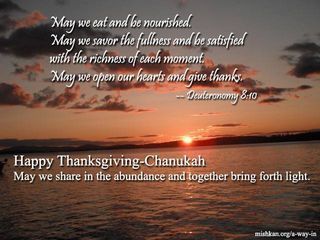
This holiday greeting card comes courtesy of A Way In | Mishkan Shalom.
Wishing a joyous pair of holidays today to all who celebrate!
November 27, 2013
Saladin Ahmed's Throne of the Crescent Moon
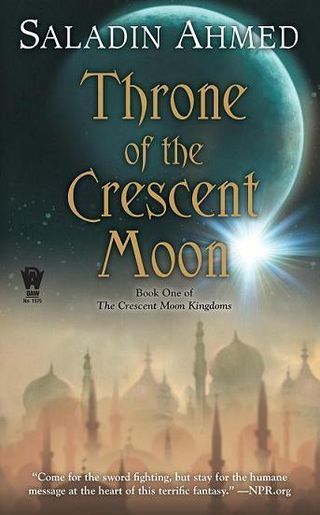 Longtime readers know that I'm a fan of speculative fiction. For those among y'all who share that interest, I'm here to recommend Saladin Ahmed's Throne of the Crescent Moon, the first book in the Crescent Moon Kingdoms series.
Longtime readers know that I'm a fan of speculative fiction. For those among y'all who share that interest, I'm here to recommend Saladin Ahmed's Throne of the Crescent Moon, the first book in the Crescent Moon Kingdoms series.
I loved pretty much everything about this book. And I don't want to spoil it for those who haven't read it yet, because part of the joy of it is seeing how its world unfolds through its twists and turns. But I can say a few things without venturing into spoiler territory, and the first one is: this book has great characters. They are real, whole, complicated people and I come away from the book wanting more -- not because Ahmed didn't give us enough, but because I just want to keep hanging out with them and vicariously experiencing their adventures.
This book also does a gorgeous job of depicting a fantasy world which draws on the tastes and textures and smells and sounds and mythologies of a place which is not Western. Reading Crescent Moon catapults me directly into every time I've been blessed with the opportunity to walk the twisty crowded ancient streets of of Cairo, Jerusalem, Amman. This book isn't set in our world, but it evokes some places which are in our world; it feels true to those places even while it goes above and beyond the lived reality of those places. And the same is true of the book's mythology / folklore / magic -- some of it draws on preexisting stories and ideas (djinn, ghuls), and some of it is Ahmed's own creation.
I like the different forms of religiosity we see here -- most especially the balance between Adoulla and his young companion Raseed. Adoulla's middle-aged, world-weary, and humor-laced way of being religious doesn't always dovetail neatly with Raseed's youthful fiery desire for spiritual purity, and that difference is neither ignored nor resolved; they exist side-by-side. I like the young lioness Zamia Laith Banu Badawi, and her growing sense of kinship with the alkhemist Litaz, despite their differences. We get just enough of each of their stories to make them real and whole -- and just little enough that I really want more of both of them. (Here's hoping they're both in the next book, eh?) And I like that Zamia and Raseed's relationship remains complicated and interesting to the end of the book -- there were a few different easy ways out, and Ahmed didn't take any of them.
And I like how Islam is reflected and refracted in this book. These characters aren't Muslim, precisely, in the same way that Dhamsawaat isn't any earthly city -- but in their ways of interacting with scripture, and their ways of talking about God, they evoke Islam for me as a reader, as I think they are meant to do. Hanging out with these characters makes me think of things I learned while studying Islam (particularly Sufism) in rabbinic school; the quotations from scripture have the same ring, to my ear, as translations of the Qur'an. And I really like the centrality of faith in the way the narrative unfolds. God is all over this book, is what I'm saying, and -- no surprise -- I love that. I find myself thinking of how the Narnia books aren't explicitly Christian, though to a reader who knows Lewis' theology, Christian ideas are visible in the book. (Actually, full disclosure: that was Ethan's insight.) I think this book works with Islam in a parallel kind of way.
I've read a number of really good books lately which work with entirely non-Western mythologies, characters, landscapes. None of them are set in our world, exactly. G. Willow Wilson's Alif the Unseen (reviewed here) probably comes closest to our world. N.K. Jemisin's Dreamblood duology and Elizabeth Bear's Eternal Sky books evoke aspects of this world's histories and cultures in really fascinating ways, but they're not set in this world. (Bear does neat things with an alternate-universe Mongolia, and Jemisin's books evoke ancient Egyptian culture and mythology.) All of these books open up vistas beyond the ones we've known, while also managing to give us new ways of thinking about the world we do inhabit. Come to think of it, that's what good speculative fiction always does, for me. Anyway. If this is the sort of thing you like, this book is definitely one to get. And hey! right now only it's six dollars for the Kindle, making it an easy gamble to take.
A few Chanukah gems
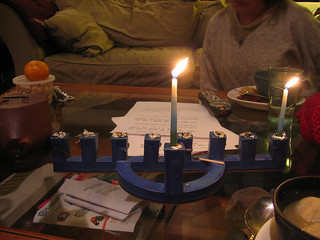 In ten years of blogging at Velveteen Rabbi, I've shared a fair number of Chanukah posts. As the holiday approaches (tonight at sundown!), I thought I'd highlight a few of my favorites:
In ten years of blogging at Velveteen Rabbi, I've shared a fair number of Chanukah posts. As the holiday approaches (tonight at sundown!), I thought I'd highlight a few of my favorites:
Chanukah has sparked a few poems, among them Excavating the Herodian oil lamps (2013) and Rededication (2012)
A call for kindness during Kislev (2011) "This can be a challenging season. Here in the northern hemisphere the days are darkening (and at the latitude of northern Berkshire, the days feel short indeed!) Thanksgiving is an opportunity for gathering with loved ones, feasting, and cultivating gratitude...though for those who are alone, the family feast day may feel even more isolating. And even for those who are blessed to gather with family, a holiday like Thanksgiving may raise or exacerbate old tensions and old hurts. On top of that, of course, some of us are introverts -- which means that concentrated togetherness-time, even if it's something we anticipate and savor, can be draining."
Mai Chanukah? (2008) "This is the time of year when people argue about the meaning of Chanukah. // It's an old question. Mai chanukah? is how the rabbis begin the Talmud's discussion of the holiday: "What is Chanukah?" Maybe the simplest answer is, it's a multivalent holiday; it always has been..."
Enough (2007) "During Chanukah we celebrate the miracle of unexpected abundance. The cruse of oil that shouldn't have sufficed, sufficed. We came face-to-face with a lack, and acknowledged the lack, and acted as though there were enough anyway, and that leap of faith made it so that there was enough."
How Chanukah feels (2005) "Chanukah feels like a box of chocolates I get to enjoy at just the right pace: one at a time, stretching the box out to last a whole week, parcelling out the sweetness bite by bite."
The smallest miracle (2003) "[According to the Sfat Emet] Chanukah was the last miracle God performed for us, so we must find special strength in it...Since God hasn't done any further big miracles, it therefore stands to reason that we're still being sustained by the light of the Chanukah miracle."
(You can find all of the Chanukah-related posts in the Chanukah category.) Chag sameach!
Image source: my flickr stream.
November 25, 2013
In advance of Thanksgivukkah
Thanksgiving (and Chanukah) (and Thanksgivukkah) are almost upon us! In light of that, here's a revised version of the blessing before the Thanksgiving meal which I first posted last year.
A Prayer Before the Thanksgiving Meal
We thank You for this meal
and for all arrayed around this table;
for the earth from which this food emerged
and Your blessing which sustains that earth;
for the hands which planted and weeded and watered
and tended animals with loving care;
for the drivers who ferried ingredients to our stores
and the workers who stocked the shelves;
for the ones who cooked what we eat today
and those whom we remember as we dine.
Help us to receive this meal as a gift
and to offer gratitude in return.
May the abundance which we enjoy
spur us to care for those who need.
Blessed are You, Source of all being,
Whose abundance is manifest on this Thanksgiving day.
If you're looking for a prayer which is specific to this unique confluence of holidays, Rabbi Jason Miller has written a lovely Prayer for Thanksgivukkah. Edited to add: here are several prayers for Thanksgivukkah, written by a variety of different rabbis, at HuffingtonPost; I really like Rabbi Brad Hirschfield's.)
(And allow me to point to one more post about the confluence: Rabbi Laura Duhan Kaplan's Thanksgivukkah: The True History.)
And speaking of the confluence of holidays, much has been made of the notion that this won't happen again for thousands of years. But Rabbi David Seidenberg makes a compelling case for why Thanksgivukkah will happen again in 2070 -- and offers the beautiful suggestion that on this Thanksgivukkah, we bless our children or grandchildren who we hope will live to see that next Thanksgivukkah.
Carving new grooves on heart and mind
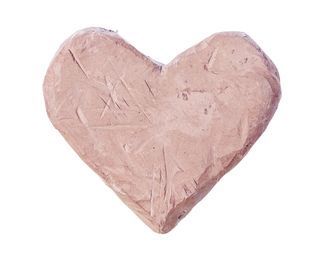 It's always surprising to me -- though it probably shouldn't be -- how easily the mind becomes accustomed to a thought pattern, and gets stuck there. Our repeated thoughts carve grooves on the soft clay of our consciousness, and soon a thought process goes from occasional to regular to habitual.
It's always surprising to me -- though it probably shouldn't be -- how easily the mind becomes accustomed to a thought pattern, and gets stuck there. Our repeated thoughts carve grooves on the soft clay of our consciousness, and soon a thought process goes from occasional to regular to habitual.
This is one of the reasons why I am so attached to my gratitude practices, praying modah ani in the morning chief among them. When I school myself in the practice of saying thank-you to God for being alive again, day after day, that helps me to wake up in that spirit and to carry it with me into the morning. Or if I pause before eating a piece of toast and say the hamotzi, recognizing the hands which sowed and milled the grain and the divinity which sustained both the grain and the people who turned it into bread, then that shapes my experience of eating.
By the same token, if there's something that's anxiety-provoking, it's easy for the anxiety to become as habitual as the gratitude. (Or even more so.) For some of us, the approach of winter can bring on that pattern. As sunset comes earlier and earlier, a clench of worry can take hold of heart and mind: it's so dark, I don't know how I can live with this. For others, the winter holiday season brings anxiety: too much pressure, not enough money, maybe we feel we don't fit in with what "everyone else" is celebrating or how they're celebrating it. Each of us has different inflection points which bring on this kind of thinking, but it's an experience we all have.
Last spring at the last Rabbis Without Borders retreat, I learned about negativity bias -- the phenomenon whereby if one gets nine compliments and one piece of hate mail, the hate mail lodges more firmly in one's memory than the praise. And I also learned that negative / anxious / unhappy thinking tends to reinforce itself. Or, framed another way, the more we focus on what's broken, the harder it can be to see what's whole. And every time we retread that negative ground, we wear its path even more firmly into our hearts and minds.
Like everything else in spiritual life, I find that this kind of consciousness ebbs and flows. Sometimes I'm paying a lot of attention to the grooves I'm carving; other times, I snap awake and realize that I've been carving without noticing. Spiritual life may be a constant practice of noticing that one has fallen out of mindfulness, intentionally shifting focus and paying attention again, and then noticing that one's fallen out of that attention again! But when we wake up and recognize that we haven't been paying enough attention, it's worth looking at the grooves we may have carved without active intention. (As my teacher Reb Zalman has taught, the mind is like tofu: it takes on the flavor of whatever it's steeping in. Different metaphor, same truth.)
It's a long time since I've done anything with clay, though I used to really enjoy amateur pottery when I was a kid. Though it's been decades, my fingers can still remember the feeling of dipping into a bowl of slip and smoothing away the lines or cracks in a given clay creation. How can we do that with our hearts and minds? Having recognized the places where we've missed the mark in our thoughts and feelings, the grooves we didn't mean to carve, how do we smooth them away and return to the soft blank slate on which we can seek to carve new channels for our thoughts and feelings to follow?
A dear friend of mine who works as a therapist tells me that the conventional wisdom in her field is that it takes ten days to drop a habit, and thirty days to gain a new one. Ten days of a negative practice or thought are enough to engrain it as a habit. And as far as un-doing that habit -- if you practice something daily for thirty days, she says, it becomes a new habit (or in the metaphor I've been using, a new groove on heart and mind.) When you find yourself returning to the old groove, she says, just try to notice that -- without judgement -- and then redirect your thoughts in the opposite direction. If you catch yourself dreading the darkness, gently redirect your thoughts to a reason why the darkness can be velvety and lovely. (For instance: it's easier to sleep in when it's still dark in the mornings!) And so on.
Jewish tradition offers tools and techniques for keeping our minds steeping in a marinade of gratitude and mindfulness. One of these is the practice of making blessings -- over food, over our experiences and activities, over the wonders we see in the world. (We read in Talmud that each of us should strive to make 100 blessings each day.) Blogger Lindsey Mead just posted about noticing the beauty in what is: What you see is what you get. I think the process of attention and wonder which she describes is part of the process of carving these new grooves. No one can live in a constant state of radical amazement and wonder. It's impossible to fill every single moment with gratitude. But we can maintain the intention of keeping ourselves open to wonder when it arises, and to seeking wonder even in the mundane or everyday.
It's also important to be kind to ourselves as we do this work. To forgive ourselves for the times when we've accidentally fallen into thought patterns which we didn't mean to cultivate -- found ourselves in grooves we didn't mean to carve -- marinated our consciousness in a broth of negativity instead of the gratitude or kindness which we had meant to aim for.
Maybe this week is exactly the right time for noticing what grooves we've carved, and for beginning the work of carving new ones as needed. Thanksgiving (in the United States) is an opportunity to practice gratitude. And Chanukah is a festival of rededication. As the Temple was rededicated with that vial of oil which burned for eight miraculous days, so we can rededicate ourselves to this work of discernment and change. We can rededicate the sanctuary of body, heart, mind, spirit. We can clean out old anxieties and habits which are no longer fruitful, and bring light to our own darkest corners.
November 22, 2013
Some of this work's greatest blessings
It is a tremendous blessing to me every time I am able to walk alongside someone who is on the mourner's path.
To sit down in someone's kitchen or living room and let them tell me stories.
To give them a safe space in which to open the faucet and let their memories begin to pour forth.
To keep company with the family as they accompany their loved one as far as they can go.
To invite them into the painful and powerful tradition of shoveling earth onto the casket with our own hands.
To bless them that they should be consoled along with the mourners of Zion and Jerusalem, and along with all who mourn.
To walk alongside them, to offer a listening ear and a welcoming heart.
To pray with them, letting the familiar cadences of the mourner's kaddish work in and through them.
To remember how precious this life is, and how unknown is the Mystery which follows.
I don't do this work in order to be more mindful of my own life, my own loved ones, but I am always reminded.
I remember how fortunate I am that my own loved ones are still here.
It is sobering to glimpse, at a distance, the path we all walk someday.
As Shabbat approaches, may all mourners find comfort. May we welcome them into our communities with kindness and understanding. May we tend their fragility more lovingly than we would tend our own.
November 21, 2013
A poem in The Heart of All That Is
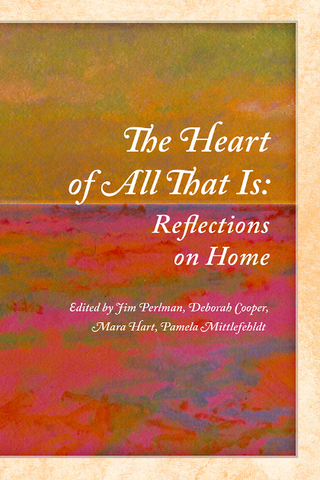 I am delighted to be able to share the news that one of my poems, "The Permeable World" (which first appeared in Waiting to Unfold, Phoenicia, 2013) has been reprinted in a wonderful anthology -- The Heart of All That Is: Reflections on Home, edited by Jim Perlman, Deborah Cooper, Mara Hart, and Pamela Mittlefehldt, published by Holy Cow! Press.
I am delighted to be able to share the news that one of my poems, "The Permeable World" (which first appeared in Waiting to Unfold, Phoenicia, 2013) has been reprinted in a wonderful anthology -- The Heart of All That Is: Reflections on Home, edited by Jim Perlman, Deborah Cooper, Mara Hart, and Pamela Mittlefehldt, published by Holy Cow! Press.
I've reviewed Holy Cow! titles here before -- both as a poet and as a rabbi, I turn frequently to Beloved on the Earth: 150 poems of grief and gratitude, which I wrote about back in spring of 2012.
When I saw the call for submissions to this anthology on home, I knew I wanted to be a part of it (if the editors were so inclined.) Home, the meaning of home, finding home, making home -- I think that all of these are central to my poetry, as well as to my spiritual life.
Home. Is it a place or a face? An address or a state of mind? Shelter or prison? Hearth or horizon? ...Home is not static. It is a verb, as well as a noun, a description as well as a destination. Home is a dialectic, an oxymoron. Implicit in the grounding promised by the idea of home is the syncopated counterpoint of yearning -- a longing to flee as well as an ache to return.
That's from the introduction, written by co-editor Pamela Mittlefehldt.
The anthology is, of course, beautifully printed and put-together. And in its pages are poems by some poets whose work I already knew -- Marge Piercy, Jane Yolen, Naomi Shihab Nye -- as well as many poets whose work is not yet known to me; new poetic worlds to discover.
I love Laura Hansen's "What Holds Me" -- "What holds me together is this house / two steps up from the shore of the river, / the closets filled to overflowing / with old rubber boots and overcoats..." And Ethna McKiernan's "Dear God of H____" -- "Rain down, oh rain down, you desolate / blessed God of homelessness..." And Margaret Hasse's "Prairie World and Wanderer" -- "At one end of a tunneled corridor / we took naps, once finding where a deer // had tamped a sleeping space, still warm." And Miriam Weinstein's "Home is a complete sentence" -- "Will you complete the precarious walk // across what now looks like a very thin balance beam?"
It's a beautiful collection. I'm glad to be a part of it.
Purchase the anthology directly from Holy Cow! Press at $18 | or from Amazon at $13.64 | or from your local bookstore.
November 19, 2013
The other story in this week's Torah portion: Judah and Tamar
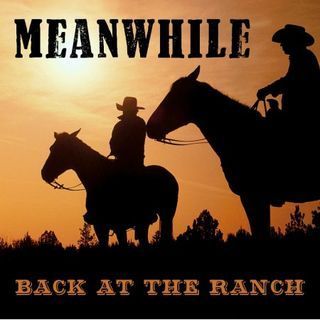 This week we're in parashat Vayeshev. This Torah portion brings us into one of the richest narratives in Torah: the beginning of the Joseph novella. But just as the Joseph story is getting rolling, we pause for an interlude which contains an entirely different story, the story of Judah and Tamar. Here's a refresher in case you can't remember how this one goes:
This week we're in parashat Vayeshev. This Torah portion brings us into one of the richest narratives in Torah: the beginning of the Joseph novella. But just as the Joseph story is getting rolling, we pause for an interlude which contains an entirely different story, the story of Judah and Tamar. Here's a refresher in case you can't remember how this one goes:
Judah (one of the brothers who sold Joseph into slavery) parts ways with his brothers, marries, and has three sons. The first son, Er, marries a woman named Tamar -- but Er dies before a child can be conceived. So Judah does what was apparently commonplace at that moment in time: nudges his son Onan into levirate marriage.
(What's levirate marriage? It's what happens in the Biblical paradigm when one brother dies childless: the other brother is obligated to marry his brother's widow, and if their marriage produces a son, that son is considered the child of the dead brother both legally and spiritually.)
Onan doesn't want to produce a child under these circumstances. Inheritance laws of that era mean that he and his future children would take a major financial hit, and this kid wouldn't even be considered his! So he practices a form of birth control, spilling his seed on the ground. (It's worth noting that in Torah, the sin of onanism isn't masturbation, it's wasting the opportunity to father a child through levirate marriage.) Because of his sin, Onan dies, too. At this point, Judah doesn't want to marry his third son to Tamar, because she's starting to seem to him like a bad-luck charm. And the third son is too young, anyway. So he sends her back to her father's household.
Sometime thereafter, Judah's wife dies, and after he's finished mourning he goes up to a different town to get his sheep sheared. Word reaches Tamar of her father-in-law's plans, so she discards her widow's cloak and puts on a veil and stations herself on the road at a place called petach enaim, which might mean "the entrance to [the town of] Enaim," or might mean "the opening of the eyes." But when Judah finds her, his eyes are distinctly not opened to the truth of what's in front of him -- he fails to recognize her (on account of the veil), so he hires her for a night. Afterward, he offers her a goat in payment. Tamar, shrewdly, asks for his signet ring and staff as collateral. Later, when he tries to send the goat as his promised payment, no one knows anything about the woman he describes, so he shrugs and keeps the goat.
Three months pass and it becomes clear that Tamar is pregnant. This is an insult to the memory of Er and Onan, and to Judah by extension, so Judah demands that she be brought out and burned. (This is, by the way, an excessive punishment even by ancient near eastern standards -- even at its harshest, Torah does not command this. Perhaps we're meant to see Judah as a bit of a hothead.) But Tamar discreetly sends back his ring and staff, saying, "The man to whom these belong is the father of my child." Judah, suitably chastened, never bothers her again. She gives birth to twins, Perez and Zerah. Jewish tradition will later hold that the line of King David descends from Perez.
What are we to make of this story? And why is it inserted into the middle of Joseph's tale?
What Tamar did may seem weird to us, even abhorrent. But within the paradigm of that place and time, what she did made a kind of sense. Having married Er, she was entitled to a child from the line of Judah. Women who were mothers had different status than women who were not, and we can tell from Torah's frequent exhortations to care for the widow and orphan that widows and orphans had the toughest lot of all. So Tamar needs a son. Er dies before he can give her one. Onan refuses to give her one through the safeguard of the time, e.g. levirate marriage. And Judah refuses to help her any more after that. So she takes extraordinary measures to get what she believes she deserves. We may not particularly like her methods, but I think we have to admire the courage of her convictions.
The two stories have a few motifs in common. Clothing, for one: Joseph has that beautiful tunic or multicolored coat, while Tamar has her widow's weeds and then the prostitute's veil. Mistaken identity: the brothers imply to their father Jacob that Joseph is dead (by bringing him the torn and bloodied coat), and Tamar implies to her father-in-law Judah that she is something other than what she is (by taking off her widow's garb and donning a veil instead.) Another commonality is protagonists who get by on their wits. Tamar is a trickster figure -- not unlike her grandfather-in-law Jacob, who tricked his father into giving him his brother's blessing; and not unlike Joseph, who will deceive his own brothers when they come down to Egypt seeking food during famine.
Tamar is a marginal figure: she achieves motherhood, that greatest source of Biblical women's joy, by literally standing at the side of the road for her father-in-law to pass by. (It doesn't get much more marginal than that.) But through her proactive choices, she moves from marginal to central. Once Joseph lands in Egypt, a stranger in a strange land, he becomes marginal, too -- until he works his way into the center of his story again.
And both stories feature a dramatic reveal. When Joseph's brothers meet him as Pharaoh's vizier, they won't recognize him, and when he finally tells them who he is they are amazed. When Judah meets Tamar on the road, he doesn't recognize her. In some ways, her reveal is even more dramatic than Joseph's was: she reveals not only her own identity, but Judah's identity as father of her child. She tells Judah something he didn't know about himself, that he's a father again. And maybe she also tells Judah something he doesn't want to know about himself: that he was wrong in trying to subvert the levirate system, thereby denying her the stature and status which was legitimately hers. In this, she prefigures Ruth (who will marry Boaz in another levirate situation), who responds to Boaz's question ("who are you") by telling him who he himself is.
The sages of Jewish tradition respond to Tamar with praise. Tamar is compared to the matriarch Rebecca (who likewise covered herself with a veil, and likewise gave birth to twins.) Bereshit Rabbah even goes so far as to say that an angel helped make sure that Judah chose Tamar rather than anyone else he met that day! In this, I suspect, our sages are working backwards from the teaching that the line of David will descend from Perez. If King David will descend from Perez, then Perez's mother's machinations must be praiseworthy rather than suspect.
In the Five Books of Miriam, Ellen Frankel suggests that this whole episode is a test of Judah's character -- a test which he roundly fails. Writing in the voice of an imagined Tamar, she rails:
He'd already failed to enforce his family's levirate obligation. He'd sent me home in disgrace to my father's house. Now, by his cavalier surrender of his name and power, he conclusively proved his unworthiness as paterfamilias. And so once the bargain was sealed, it was I who left him and went on my way; he remained behind, stripped of his identity. From that moment on, the family birthright passed to me, the mother of Judah's heir.
Tikva Frymer-Kensky's commentary at the Jewish Women's Archive notes that according to ancient near eastern custom, Judah had two legitimate choices, and chose neither. He should either have continued the family line in accepted levirate fashion, or set Tamar free as a widow who could remarry. He does neither, which effectively keeps her in limbo. Reading that, I can't help but think of today's agunot, "chained women," who are bound in marriage to husbands they no longer want because their husbands refuse to give them a get, a halakhic writ of divorce. But Tamar has different options than do today's agunot. When fate deals her a bad hand of cards, she takes her story into her own hands. She ensures that she will bear a child from the line of her dead husband's family, thereby furthering that family line. And along the way, she shows Judah that she is no one to be trifled with.
In a way, Tamar's story highlights for me how distant these Biblical narratives can feel from our own day. Levirate marriage -- seeking out her father-in-law in disguise by the side of the road -- these are foreign to us indeed. And in another way, Tamar's story highlights for me how familiar these Biblical stories can feel. She's a plucky protagonist who'd be right at home in a modern novel. And the story's themes of hiding and revealing, deception and triumph, are alive and well in our world.
How do we (like Tamar) hide our true selves when we're out and about in the world? What do we see (unlike Judah) when we position ourselves in a place where we can truly open our eyes? How are we drawn up short (like Judah) when we recognize the consequences of our actions? What blessings can we imagine might arise (as they did for Tamar) from the distant outcomes of what we choose to do?
New poem, On Joseph and solitary confinement, at T'ruah
 Once again, T'ruah: the Rabbinic Call for Human Rights is encouraging the observance of Human Rights Shabbat in early December -- a Shabbat dedicated to learning about, and rededicating ourselves to, the work of human rights in our world.
Once again, T'ruah: the Rabbinic Call for Human Rights is encouraging the observance of Human Rights Shabbat in early December -- a Shabbat dedicated to learning about, and rededicating ourselves to, the work of human rights in our world.
They've just put a set of Human Rights Shabbat resources online. Those resources include kavanot (mindful intentions) to hold in mind and heart, such as this kavanah for Mi Chamocha by Rabbi Jill Hammer [pdf]; a Prayer for human rights by Rabbi David Friedenberg [pdf]; and also a new poem of mine, On Joseph and solitary confinement [pdf]. My poem draws on the set of weekly parshiyot into which we are entering this week -- the Joseph novella -- and then moves from the Torah story to injustice in the prison system today.
Here's how my poem begins:
When Joseph was jailed, wrongly accused
of seducing his master’s wife, what did he feel?
Did he remember his first stint in solitary,
the pit where his brothers threw him --
empty of water but crawling with scorpions,
empty of Torah but reeking with resentment?
Each time he prepared to start over
life cast him down someplace worse.
But he knew all along that God was with him
and that God meant everything for good...
You can download my poem, as well as many other terrific resources for Human Rights Shabbat, on the T'ruah Human Rights Shabbat resources page.
November 18, 2013
Where fandom and religion coincide
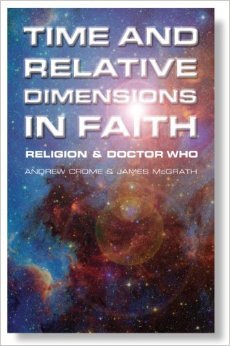 A surprise arrived for me in the mail this morning: a complimentary copy of Time and Relative Dimensions in Faith, a new anthology which explores the role of religion in Doctor Who, coedited by Andrew Crome and James McGrath, newly released by Darton, Longman & Todd.
A surprise arrived for me in the mail this morning: a complimentary copy of Time and Relative Dimensions in Faith, a new anthology which explores the role of religion in Doctor Who, coedited by Andrew Crome and James McGrath, newly released by Darton, Longman & Todd.
The copy came courtesy of one of the book's contributors, Joel Dark, whose essay "Doctoring the Doctor: Midrashic Adventures in Text and Space" draws on my 2012 essay for Religion & Literature, Transformative Work: Midrash & Fanfiction. He sent it to me as a sort of thank-you for having written that article in the first place, which was awfully kind of him. It's neat to see how Joel uses my essay to support his thinking about Doctor Who.
Joel writes:
A second happy accident for Doctor Who's midrashic future was the almost impossible contradictory complexity of its twenty-six year narrative. This was actually a long series of accidents. If 'surface irregularities of the text,' in the words of the biblical scholar James Kugel, are 'the grain of sand which so irritates the midrashic oyster that he constructs a pearl around it,' the original Doctor Who series was a beach.
That last sentence made me laugh out loud. A beach indeed. And, Kugel's point about midrash is a delightful one to bring to bear on Doctor Who -- and on any imperfect source-text which accrues a dedicated fandom in part because its irregularities give fans hooks on which to hang ideas and interpretations.
I've only had the chance to read two other essays in the book so far. One is Brigid Cherry's "'You're this Doctor's companion. What exactly do you do for him? Why does he need you?': Doctor Who, Liminality, and Martha the Apostle." I like her analysis of Martha (the companion) as an apostle, and she makes good points about the show's treatment of apocalypse and of spreading the good news.
And the other is Kristine Larsen's "Karma, Conditionality and Clinging to Self: the Tennant Years as Seen Through a Tibetan Buddhist Lens." I like her Buddhist reading of the show, and particularly her analysis of David Tennant's final episodes. (His Doctor really wasn't ready to accept his impermanence, was he?)
Reading Cherry's Christian analysis of the show, and Larsen's Buddhist analysis of the show, I find myself wondering what a specifically Jewish analysis of Doctor Who would look like. Of course, this being the internet, someone else has had that thought before I did, and has posted about it, too: Liel Liebovitz's Doctor Who? Doctor Jew: Doctor Who is the Greatest Jew on Television, in Tablet. Also, apparently 2011 brought us Naomi Alderman's Borrowed Time, the first Doctor Who tie-in novel written by a Jewish woman -- you can read about it in the Forward, and/or in this interview Doctor Who / Is A Jew?, which explores the Doctor's talmudic reasoning and features a charming visual of Matt Smith's Doctor wearing a kippah.
I'm looking forward to dipping further into the book as time permits. (And receiving it reminded me to put Chicks Dig Time Lords on my Amazon wishlist...)
Rachel Barenblat's Blog
- Rachel Barenblat's profile
- 6 followers



